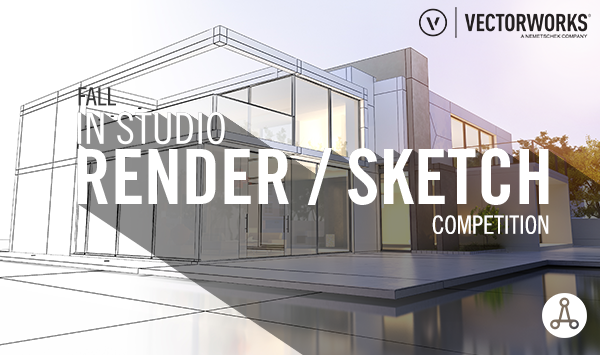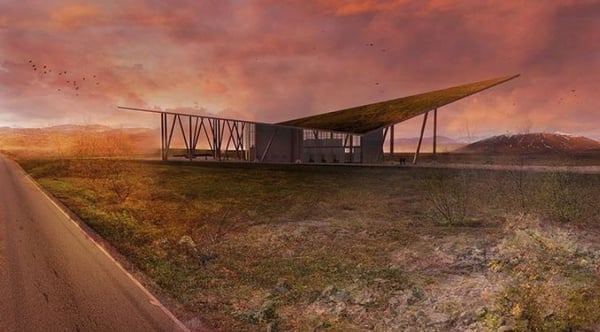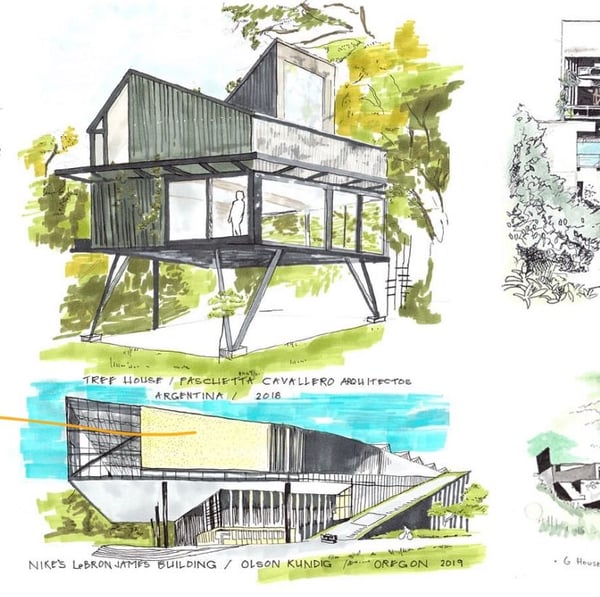In 2018, we partnered with the
American Institute of Architecture Students (AIAS) to run the In Studio Render/Sketch competition, where students can post their best sketches and renders to share with our
Instagram account. 2019’s competition saw tons of stunning entries and the winners are in.
The winners of the 2019 In Studio Render/Sketch competition are:

“As part of the submission process, AIAS members had to tag Vectorworks’ Instagram handle when they uploaded their designs, and it was phenomenal to witness all of the inspiring and creative design submissions from students,” said Alice Lowy, marketing programs director at Vectorworks.
“The fundamental mission for Vectorworks is enabling great design to occur. We’re grateful for our continued partnership with AIAS, and it’s wonderful to see great designs materializing with the future generation of architects.”
First Place: Alex Geisen
From Washington State University, Alex Geisen submitted the first of her two-phase project. Pictured is a “museum with a butterfly green roof and grasscrete around the bottom of the forested, angled columns to allow as much local vegetation as possible to prosper,” the winner captioned her Instagram post.

Geisen notes that the second phase of her project includes a luxury hotel and a research facility.
Second Place: Deiland Slaughter
Slaughter, from Fairmount State University, took second place for a compilation of watercolor sketches.

“A compiled piece of this past semester’s work of 5 weekly sketches on an 11x17 paper,” he captioned his post. “Each building we picked, we explained why we did and told its ordering principle.”

Third Place: Lauren Wertz
Third place goes to Auburn University’s Lauren Wertz, who proposed a redesign of Atlanta, Georgia’s contemporary art museum.

“The main idea of this project is composition and an emphasis on vertical movement: the overall form of the building is determined by a series of pushes and pulls, creating voids to facilitate outdoor exhibitions and events or creating compositional variations in the façade,” she captioned her post. “With the idea of a “contemporary art museum,” the building was designed with the intent for it to be a work of art itself.”
 “As part of the submission process, AIAS members had to tag Vectorworks’ Instagram handle when they uploaded their designs, and it was phenomenal to witness all of the inspiring and creative design submissions from students,” said Alice Lowy, marketing programs director at Vectorworks.
“The fundamental mission for Vectorworks is enabling great design to occur. We’re grateful for our continued partnership with AIAS, and it’s wonderful to see great designs materializing with the future generation of architects.”
“As part of the submission process, AIAS members had to tag Vectorworks’ Instagram handle when they uploaded their designs, and it was phenomenal to witness all of the inspiring and creative design submissions from students,” said Alice Lowy, marketing programs director at Vectorworks.
“The fundamental mission for Vectorworks is enabling great design to occur. We’re grateful for our continued partnership with AIAS, and it’s wonderful to see great designs materializing with the future generation of architects.”
 Geisen notes that the second phase of her project includes a luxury hotel and a research facility.
Geisen notes that the second phase of her project includes a luxury hotel and a research facility.
 “A compiled piece of this past semester’s work of 5 weekly sketches on an 11x17 paper,” he captioned his post. “Each building we picked, we explained why we did and told its ordering principle.”
“A compiled piece of this past semester’s work of 5 weekly sketches on an 11x17 paper,” he captioned his post. “Each building we picked, we explained why we did and told its ordering principle.”

 “The main idea of this project is composition and an emphasis on vertical movement: the overall form of the building is determined by a series of pushes and pulls, creating voids to facilitate outdoor exhibitions and events or creating compositional variations in the façade,” she captioned her post. “With the idea of a “contemporary art museum,” the building was designed with the intent for it to be a work of art itself.”
“The main idea of this project is composition and an emphasis on vertical movement: the overall form of the building is determined by a series of pushes and pulls, creating voids to facilitate outdoor exhibitions and events or creating compositional variations in the façade,” she captioned her post. “With the idea of a “contemporary art museum,” the building was designed with the intent for it to be a work of art itself.” 




